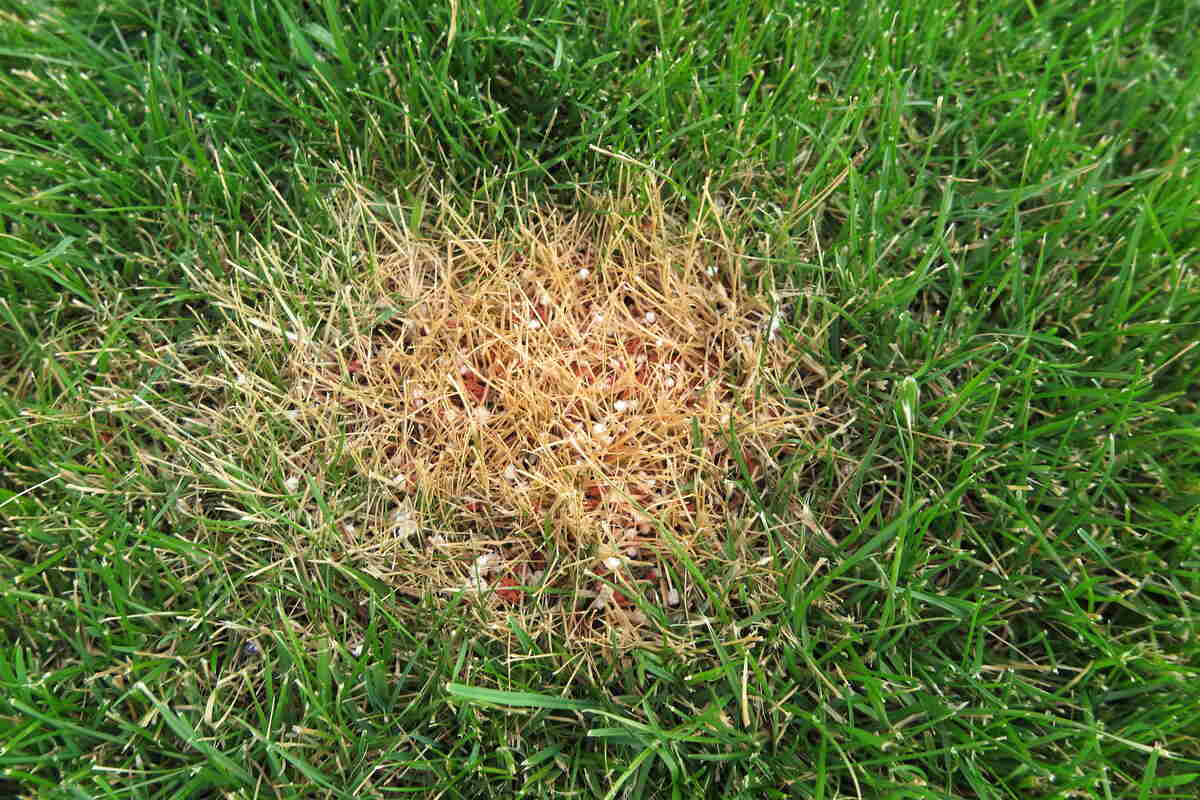
Fertilizer burn is the result of too much of a good thing — applying too much fertilizer. But applying the wrong type of fertilizer or applying it improperly are other common causes.
We’ll also take a deep dive into how to identify the signs and symptoms of fertilizer burn and how to distinguish it from other lawn care issues.
What is Fertilizer Burn?
Fertilizer burn is a type of drought stress. This burning happens when too much fertilizer is added to your lawn or garden, causing discolored streaks on blades of grass, patches of “scorched” yellow or brown grass, or a lack of grass growth.
As a lawn care do-it-yourselfer, you may be tempted to apply extra fertilizer for good measure. But when it comes to fertilizers, too much of a good thing can give you the opposite result. Excess fertilizer can:
- Kill your grass
- Contaminate nearby waterways
- Harm wildlife
- Disrupt soil microbial growth
Pro Tip: To avoid fertilizer burn, hire a local lawn treatment pro to fertilize at the ideal rate at the right times throughout the year.
How Does Fertilizer Burn Happen?
Fertilizer burn happens when too much salt builds up in the soil. Here’s why: Synthetic fertilizer components (nitrogen, phosphorus, and potassium) are salts that allow for a quick release and uptake of nutrients for your lawn or plants.
This quick-release can provide your lawn with a fast influx of helpful nutrition, which can be a good thing. However, an excessive concentration of these salts in the soil (such as after a fertilizer spill) is detrimental.
In high amounts, these salts draw out too much water from the grass. As a result, the grass dries up, leaving brownish patches of burned or dead grass throughout your lawn.
Signs and Symptoms of Fertilizer Burn

After you fertilize your lawn, look for these signs of fertilizer burn:
- Discoloration on grass blades
- Patches where the grass stops growing
- Patches of burned grass OR
- Burned grass in the form of a square or strands of burned grass in a checkerboard shape. This is usually caused by too much overlap as you apply the fertilizer.
Differences Between Fertilizer Burn and Other Lawn Problems
Some of these signs are also signs of lawn diseases, pesticide or herbicide damage, dryness, or maybe your pet has been peeing in that spot. Here’s how can you tell the difference between a fertilizer burn and other lawn problems:
- With fertilizer burn, the grass will typically be crispy or crunchy to the touch.
- You might also see root rot and impaired growth.
- You might notice a salt “crust” on top of the soil.
Causes of Fertilizer Burn

So you’ve got fertilizer burn. But what might’ve caused it? Here are the most common causes of fertilizer burn:
- Excessive fertilizer application. If you’re not applying the recommended amount on the label or you miscalculate the size of the area, you risk burning your lawn.
- Applying fertilizer under dry, hot conditions. Fertilizing a heat-stressed lawn or excessively dry turf can further damage the grass instead of helping it. Wait until weather conditions normalize and your grass recovers from stress before fertilizing. (Learn When to Fertilize Your Lawn in our article.)
- Using quick-release fertilizer instead of slow-release fertilizer.
- Using a product with the wrong NPK ratio for your soil can also cause burns. Conduct a soil test annually.
- Leaving fertilizer granules on grass blades. Water the lawn immediately after spreading the granules to dissolve them.
- Leaving the hopper open. When using a fertilizer spreader, close the hopper every time you need to turn, stop, or refill.
See Related:
- How to Fix an Over-Fertilized Lawn
- How Do You Know You Over-Fertilized Your Lawn?
- Fertilizer Numbers: Why They Matter and What They Mean
- How Much Does Lawn Fertilization Cost?
Types of Grass Most Susceptible to Fertilizer Burn

Any turfgrass is susceptible to fertilizer burn, especially during drought, if the soil salinity is high, or if you apply the product incorrectly. However, you can expect varieties and cultivars that have fine-textured grass blades or shallow roots to be more sensitive to fertilizers and burn more easily:
FAQ About Fertilizer Burn
The time it takes for your lawn to recover from fertilizer burn depends on the degree of the damage. Depending on the severity of the burn, the grass can take from 1 week to 1 month to recover. Or, if it has died, you’ll need to remove the grass and plant grass seed or lay sod.
For a more in-depth discussion about this topic, check out our article: How Long Does It Take for Burnt Grass to Grow Back?
Yes, although the chances are reduced, organic fertilizers can still burn your lawn or plants if you apply too much or apply improperly.
See Related:
Organic vs. Synthetic Fertilizer: What’s the Difference?
You can prevent fertilizer burn by never fertilizing a stressed lawn, fertilizing only when the grass is dry, and following the product label closely. Additionally, choose the right lawn spreader for your yard and avoid overlapping when spreading the fertilizer.
See Related:
Best Fertilizers for Grass
Common Fertilizer Mistakes to Avoid
Hire a Lawn Treatment Pro Near You
If you’re worried about dealing with a burned lawn alone, entrust your lawn to a local lawn treatment pro. A trusted pro can treat your burned areas and even make future fertilizer applications for you. Get a quote today.
Sources:
- “Fertilizer Application, Don’t Get Burned.” By John Orick, Purdue master gardener state coordinator. Purdue University.
- “Fertilizer or Pesticide Burn on Vegetable Leaves.” University of Maryland Extension.
- “Fertilizer Salt Index.” A & L Canada Laboratories.
Main Photo Credit: argot / Adobe Stock